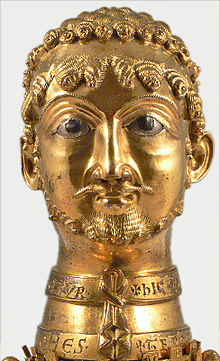Frederick I, Holy Roman Emperor
Frederick I. , called Barbarossa (Italian for "Redbeard") (b. c. 1122; † 10 June 1190 in the Saleph River near Seleucia, Lesser Armenia), of the noble family of the Hohenstaufen, was Duke of Swabia from 1147 to 1152 as Frederick III. Duke of Swabia, Roman-German king from 1152 to 1190, and emperor of the Roman-German Empire from 1155 to 1190.
Barbarossa's election was the result of a reconciliation of interests between several princes. Probably the most important role was played by his cousin Henry the Lion, who as a result of the arrangements was able to establish a royal-like position in northern Germany. However, his longstanding promotion by the king disregarded the balance of highly aristocratic family groups and ultimately made Henry a disruptive factor for the other princes of the empire.
Barbarossa's reign was also marked by the double conflict with the Lombard League of Cities and the papacy. In a society in which honor determined social rank, violations of honor and the resulting compulsion for revenge led to decades of conflict. Barbarossa attempted to play a mediating role in the disputes between the upper Italian cities. However, he failed, attracted accusations of partisanship, and was unable to exercise the traditional ruler's duties of peacekeeping and law-keeping. The refusal of some cities to submit to the imperial tribunal had to be atoned for, given the concept of the 'honour of the empire' (honor imperii). After Tortona and Milan had been destroyed, Barbarossa intended to fundamentally reorganize the kingship in the Regnum Italicum. Old sovereign rights of the empire were reclaimed or redefined and set down in writing. All judicial sovereignty and official authority was to emanate from the empire. However, the appointment of imperial administrators and the extensive financial use of the regalia granted to the emperor met with resistance from the cities. They had long since exercised their regal and jurisdictional rights under customary law.
Unlike in Salian times, the conflict with the pope and the excommunication of the emperor did not lead to the emergence of a major opposition movement in the northern part of the empire. Only after the defeat of the imperial army at the Battle of Legnano in 1176 was the decades-long schism ended in the Peace of Venice and the conflict with the communes in the Peace of Constance in 1183. Henry the Lion had refused to assist the emperor in the struggle against the Lombard cities in 1176; at the instigation of the princes he was overthrown and forced into exile.
Even before his kingship, Barbarossa had participated in the crusade of his royal uncle Conrad III from 1147 to 1149. In his last years, he prepared another crusade after the defeat of the King of Jerusalem, Guido of Lusignan, by Saladin in 1187. The emperor set out on 11 May 1189, but he drowned thirteen months later shortly before reaching his destination.
The epithet "Barbarossa" ("Red Beard") only became a permanent part of the name in the 13th century. In the context of the German national movement of the 19th century, Frederick Barbarossa developed into a national myth. The legend of the emperor sleeping in Kyffhäuser and waiting for better times was associated with the hope of national unity.

The Cappenberg Barbarossa head was probably made around 1160. It is carried by angels kneeling on an octagonal battlement. The bust came into the possession of Cappenberg Abbey during Barbarossa's lifetime. Count Otto von Cappenberg was Barbarossa's godfather in 1122. The donation of the bust to the monastery is mentioned in his will. Since Friedrich Philippi's comments published in 1886, the bust has been regarded - not without contradiction - as a representation of Barbarossa. Cappenberg, Catholic parish church.
Search within the encyclopedia